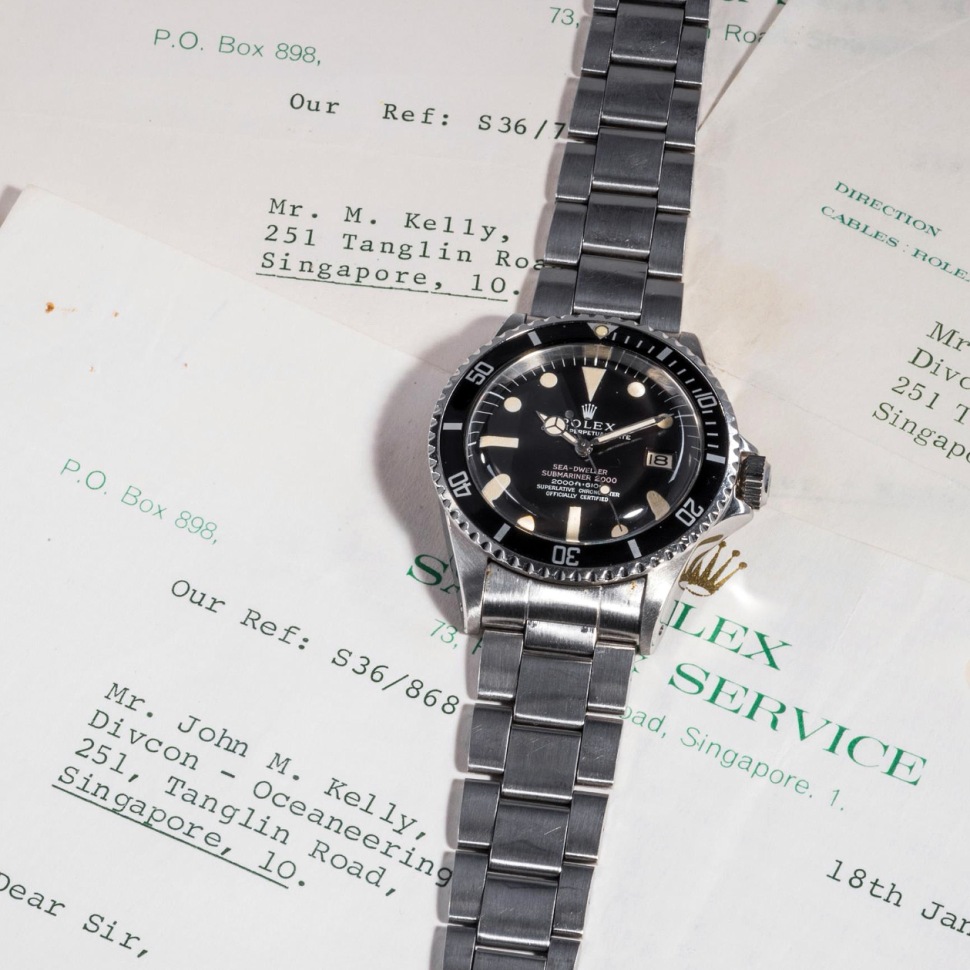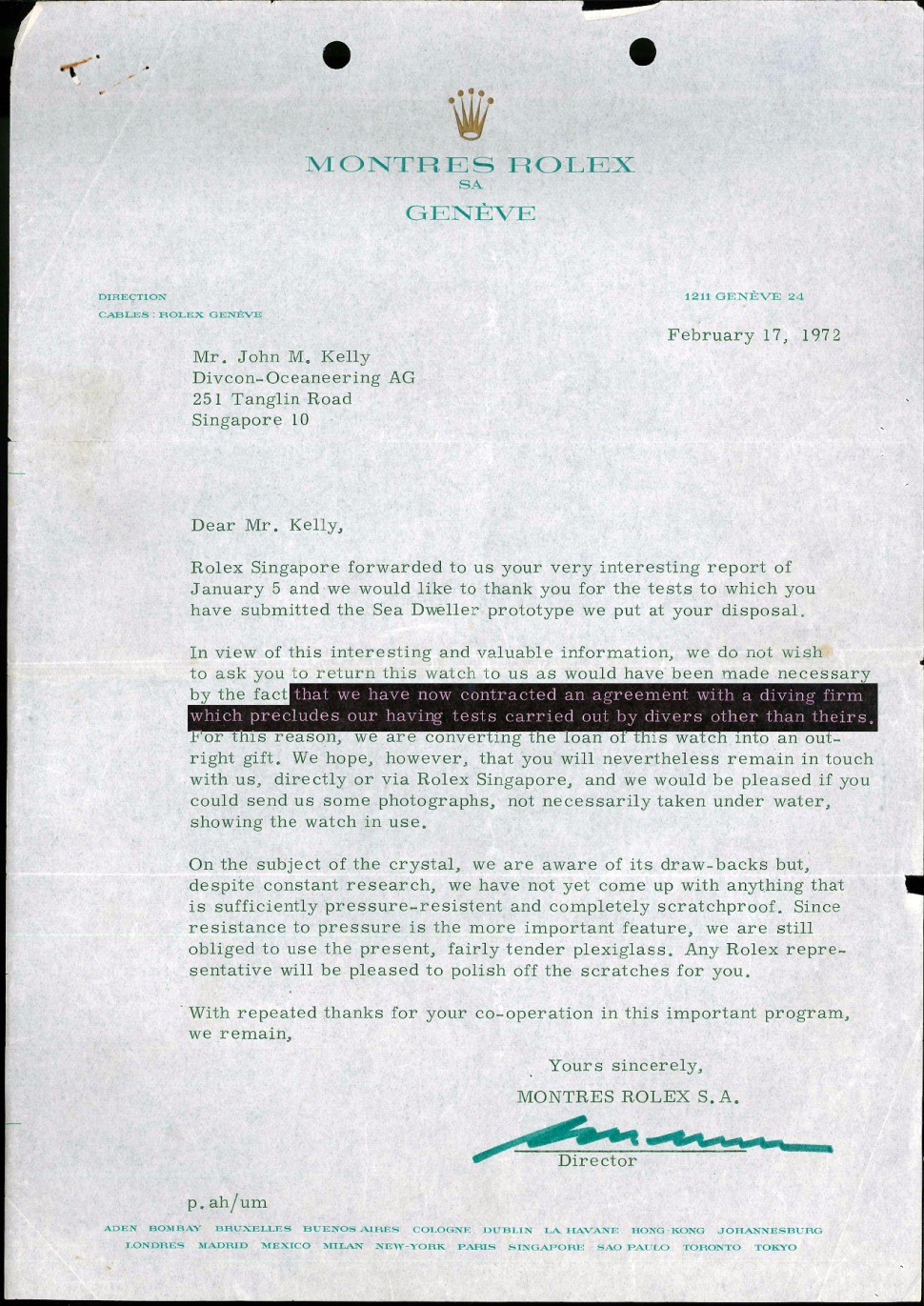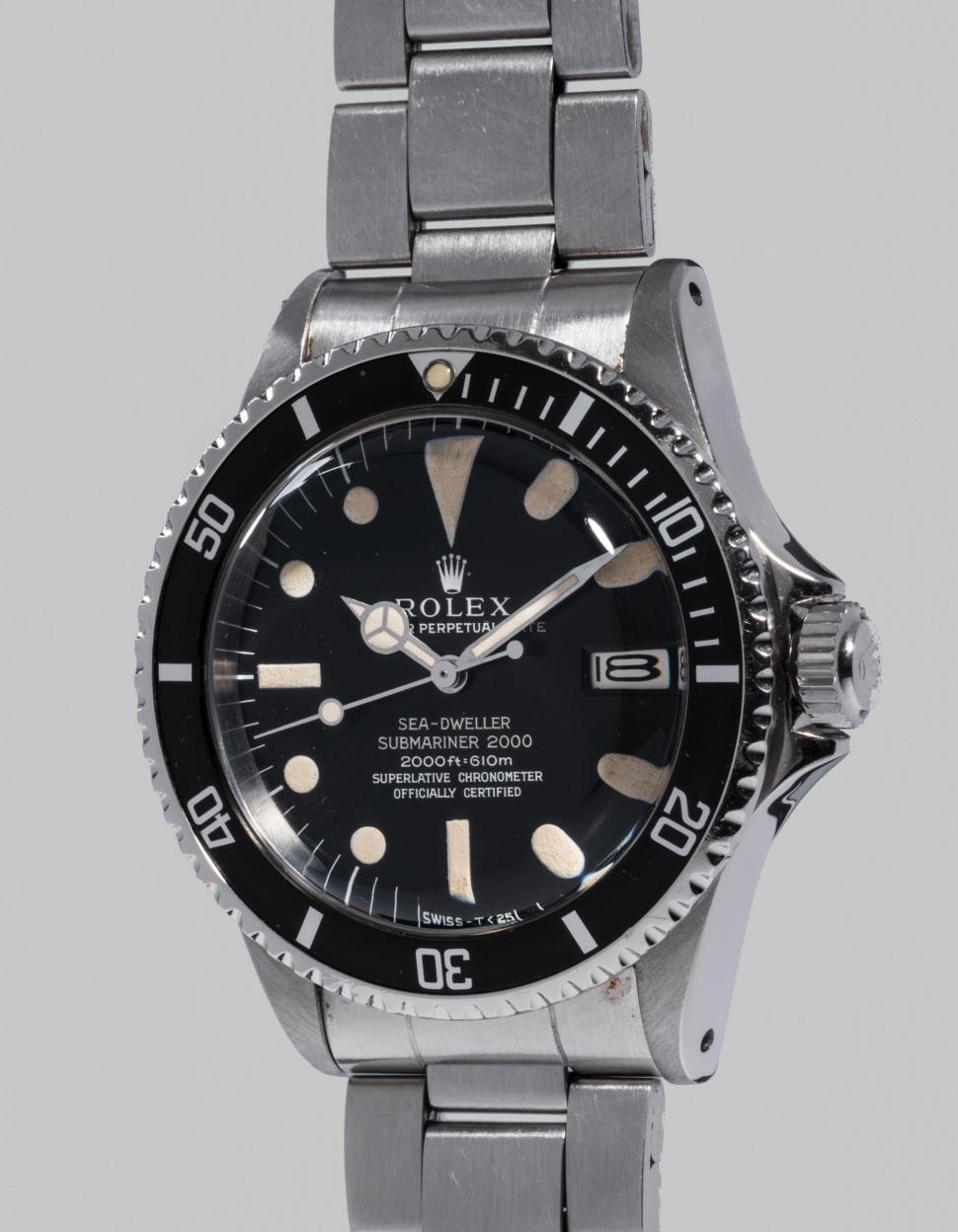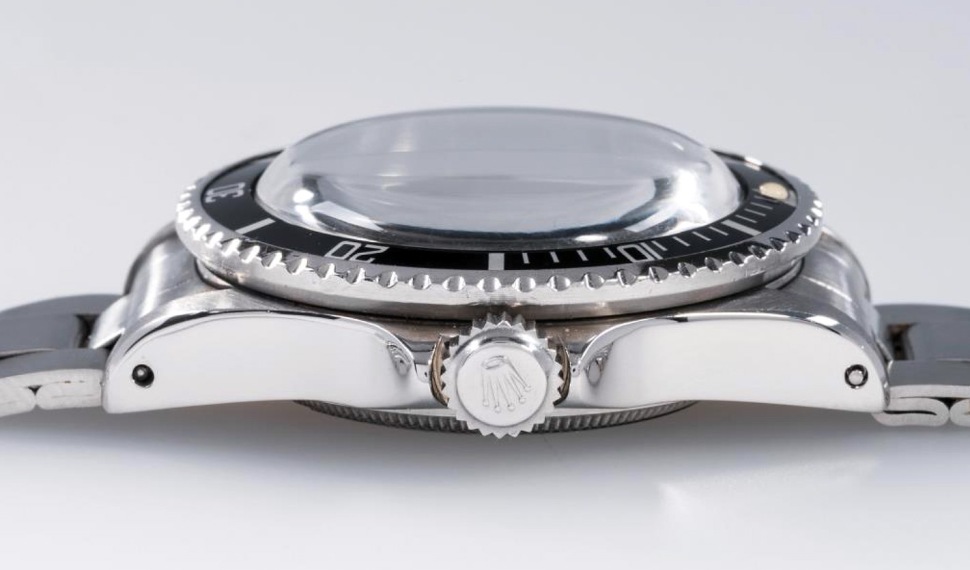Phillips Auctions in Geneva is about to auction an early Rolex “Double Red” Sea-Dweller Ref. 1665 with “Patent Pending” caseback and a fantastic provenance. The watch you are about to see belonged to Mike Kelly, a professional diver from the United States, who lived in Singapore for many years and worked as a diver on several oil rigs in Southeast Asia (Indonesia & Malaysia) and other parts of the world.
> Lot 233, Rolex Sea-Dweller Ref. 1665
Lot 233 comes with extensive documentation, letters from Rolex Singapore and Geneva, Mr. Kelly’s reports and bio, and several other documents.

.
In 1965, Mr. Kelly ended up in Vietnam, where he took a civilian position on a tugboat under the US Navy, that was hauling ammunition up and down the Mekong River. During this time he was able to purchase a Rolex Submariner from the US Military Post Exchange (PX) for US$ 90.00.
Mr. Kelly saw the opportunity to salvage construction material that was sunken with a barge in the Saigon River and make a considerable profit. Due to a lack of diving skills, he and his partner had to give up. Both travelled back to the United States in order to get a professional training in Deep Sea Diving. After completing the diving school, they returned to Vietnam and successfully completed the salvage operation.
Mr. Kelly moved to Singapore in late 1969 and was immediately hired as a diver due to his experience with explosives. In the early 1970s, Mr. Kelly signed up for the testing of a new diving watch offered by Rolex Singapore. Around the same time, his friend from Australia and his dive instructor in California were offered the same watch model by Rolex.
In June 1971, Rolex Singapore notified the American diver that the new Rolex Sea-Dweller with a special Gas Escape Valve had arrived and was ready for collection. The watch was given to him in loan, in return for submitting occasional reports on the performance of the watch every few months. Rolex also asked for “action” photographs showing the watch being used.

.
Mr. Kelly sent his first report on January 5, 1972, praising the watch and its oustanding accuracy for decompression timing. His only concern was the crystal, which was easily scratched by barnacles and other shell life common to ship hulls, etc. An example:
“November 18 through December 2: Esso Exploration of Malaysia. Drilling operations on board the Discoverer II offshore. West Malaysia in the South China sea. Water depth 340 feet (103 metres). The diving bell Seachore II system with HeO2 was used in all dives. Kirby Morgan Heavy Gear and the Advanced Hard Hat was also available for surface dives. The Kirby Morgan band mask was used out of the diving bell. Diving operations consisted of B.O.P Stack related work. Number of dives: 4 (1 observation 3 working). Comments on Rolex: Outstanding for decompression and diver timing out of the bell. No trouble in 340 feet with HeO2 environment.”
In February 1972, Rolex Geneva converted the loan into an outright gift. Imagine how happy Mr. Kelly must have been. Rolex explained, they had just signed an agreement with a diving firm (COMEX) which precluded carrying out tests with other divers or companies.

.
The mentioning of this agreement with COMEX is indeed very important. COMEX became a partner of Rolex only in late 1971. Until then, COMEX had been a partner of Omega and tested several Seamaster models during the first Janus operations, such as the Seamaster 300, Seamster 600 (Ploprof) and the Seamaster 1000 prototype. According to Patrick Cadiou, a COMEX diver of Janus II operating at a depth of 255 m (835 ft), the “Ploprof” never really worked well.
.

.
There is a widespread misunderstanding among watch enthusiasts that the Rolex Sea-Dweller – with or without Gas Escape Valve – was developed in cooperation with COMEX.
I am not sure where this myth originates from and why certain sources keep perpetuating it. Perhaps the existence of Rolex Submariners of Ref. 5513 with Gas Escape Valve led to the misconception that those were early prototypes of the Sea-Dweller. This is of course far from the truth. COMEX received those watches only in 1972 and the most plausible explanation for the existence of such watches is pretty simple: to save costs.
COMEX was not only about chasing depth records, they were a commercial diving company and most of their divers worked at depths between 50 and 100 meters (165ft – 330ft). Since they had to be pressurized and saturated with Heliox (He/O2), a breathing gas mixture consisting of Helium and Oxygen, in order to work efficiently, the watches needed a Gas Escape Valve to avoid being damaged during decompression. A Sea-Dweller would have been a financial and technical overkill for most commercial dives at COMEX.
However, I am in the possession of an audio interview with Monsieur Henri Germain Delauze (Founder and CEO of COMEX), in which he cleary stated that COMEX had nothing to do with the development of the Sea-Dweller. According to Mr. Delauze, COMEX had absolutely no technical involvement and was only responsible for testing the watches and reporting back to Rolex.
The Gas Escape Valve was born of the US Navy SEALAB I & II (1964/65) program. It was Bob Barth, the US Navy Aquanaut, who gave Rolex the idea for a decompression valve after experiencing first hand how Rolex Submariner 5512 crystals popped-off during decompression.
Rolex developed the Sea-Dweller in 1967, but until February 1969, when the SEALAB III program was launched, they had no opportunity to test the new watch under real life conditions in a saturated environment. All divers of SEALAB III were equipped with first generation Rolex Sea-Dwellers. Philippe Cousteau, the son of Jacques Cousteau, was a member of the SEALAB III Team and received an early Sea-Dweller with case number 1602920:
> Antiquorum, Lot 199, Rolex Ref. 1665 (Philippe Cousteau)
SEALAB III was aborted after only two days, as a consequence of Berry L. Cannon’s death during an attempt to repair a leak in the habitat. Rolex was again left without the opportunity to test the watches properly. The US Navy Tektite program was launched around the same time as SEALAB III. However, the Tektite habitat was placed in too shallow water (49 ft/15 m) and was probably not the right environment to test the Gas Escape Valve. This could be the reason why at least two Divers of the Tektite program received Rolex Sea-Dwellers without a Gas Escape Valve (Single Red).
These events could have led Rolex to approach professional divers and offer them the Rolex Sea-Dweller for testing.
Coming back to the Rolex Sea-Dweller at auction, the present watch is without doubt an outstanding example.

.
The dial of this watch is a “Double Red” Mark 1 (Mk 1) with typically faded SEA-DWELLER – SUBMARINER inscription. The red colour was printed over white letters and faded over time to a light pink tone.
.
This watch seems to have retained the original crown. Many expamples were equipped with modern Triplock (three dots) crowns during service.
.
For Sea-Dweller enthusiasts the Non Plus Ultra: the sought-after caseback with Patent Pending engravings. Rolex filed the Patent for the Gas Escape valve at the Federal Office for Intellectual Property of Switzerland n Nov. 6, 1967. The Patent request was published in Nov. 1969 and finally issued on Jun. 15, 1970.
.
Thoughts
I am very excited about this watch. Especially the documentation that comes with it is absolutely priceless, as it helps to set the record straight in many ways. The history of Rolex is rich and significant, it does not need false myths.
The present watch is a very important piece of the puzzle. I created a comprehensive History of the Rolex Sea-Dweller timeline and this particular watch just fits in very smoothly. Click the image to zoom in.

.
This timeline is available as a 150 cm x 85 cm (59 x 33 inch) print for EUR 120.00 plus shipping.
More about the print: The history of the Rolex Sea-Dweller at a glace




Wow! Great article. The DRSD is an amazing timepiece. Would love to connect with you Perezcope!
LikeLiked by 1 person
Hi Paul, great to hear from you! Thank you very much. I will contact you shortly.
LikeLike
Mr Kelly probably has been diving and doing work underwater in the early days of the Tapis development, the first oil Field platform, offshore West Malaysia operated by EPMI (ExxonMobile). Water depth is about right in the 100m.
LikeLike
Estimado Perezcope, te felicito por la propiedad de tus investigaciones y análisis en el mundo de la relojeria.
Recibe desde la distancia mi más alta estima y consideración desde Valencia – Venezuela.
Carlos Ruíz.!
LikeLike